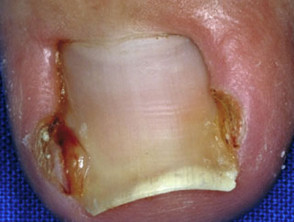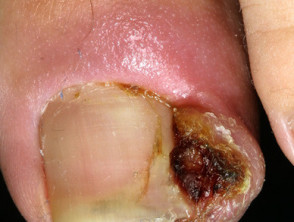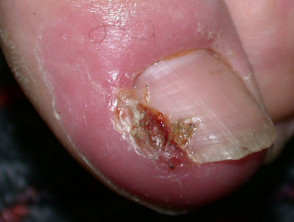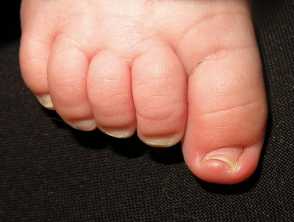What is an ingrown toenail?
An ingrown toenail is a painful condition of the toe that occurs when the sides or corner of the toenail digs into the skin at the end or side of the toe. The disease mostly affects the outer edge of the big toe, although the nail on both sides of the toe, or nail on any toe can become ingrown.
An ingrown toenail is also known as onychocryptosis.
What causes ingrown toenails?
The causes for ingrown toenails are listed below, but the two most common reasons are ill-fitting shoes and improperly trimmed nails.
- Ill-fitting shoes such as tight shoes, high heels and pointed-toe shoes cause the toes to be compressed together so that the nail curls into the skin and cannot grow normally.
- Improper trimming of toenails can cause the nail edge or corner to dig into the skin. Toenails should be trimmed straight across so that the top of the nail should make a straight line.
- Injury near the nail such as a ripped nail or nail peeled off at the edge can cause an ingrown toenail.
- Fungal infections of the nail can cause a thickened or widened toenail to develop.
- Prescribed medications, particularly oral retinoids such as isotretinoin and acitretin.
- Abnormal nail shape, such as pincer or trumpet nails.
What are the signs and symptoms of an ingrown toenail?
Ingrown toenails can be classified into three stages according to severity.
Stage 1
- End of the toe becomes reddened with mild swelling
- May feel warm and be painful to touch
- No pus or drainage
Stage 2
- Toe becomes increasingly red, swollen and painful
- May be white or yellow coloured pus or drainage from the area
- Infection may have developed
Stage 3
- Symptoms of redness, swelling and pain are increased
- Granulation tissue forms and adds to the swelling and discharge of pus
- Lateral nail-fold hypertrophy (overgrowth of skin tissue around the affected toe)
- More severe infection with fever may follow
Ingrown toenails
Pseudo-ingrown toenail of the newborn
About 2% of newborn babies are noted at birth to have ingrown toenails because the growing nail plate is very short. It is rarely painful. The appearance rights itself within a year or so.
Pseudo-ingrown toenails
What is the treatment for an ingrown toenail?
Treatment is dependent on the stage of the condition. However, at any stage of an ingrown toenail, the patient should avoid tight-fitting or high-heeled shoes. If possible, wear sandals until it has cleared up.
Stage 1 ingrown toenail should be managed conservatively using the following methods.
- Warm water soaks – soak the foot in warm water four times a day.
- Wash the foot including the affected area twice a day with soap and water.
- Cotton-wick insertion in the lateral groove corner – gently lift the edge of the nail that is digging into the skin and place a small piece of rolled cotton, gauze, dental tape or floss, between the nail and the skin to keep it elevated. This may be painful but should be done after every soaking.
Stage 2 ingrown toenail may require the administration of topical or oral antibiotics. Topical antibiotic ointments combined with local anaesthetic agents help to heal the toe faster and also provide pain relief by numbing the affected area. Surgical removal of the ingrown toenail may be required if the condition worsens.
Stage 3 ingrown toenail is often treated surgically. The surgical technique of lateral nail avulsion plus matricectomy is highly successful. A brief description of this procedure is given below.
- Local anaesthetic ring block to numb the affected toe.
- Any pus will be drained from the end of the toe.
- An ingrown toenail is cut out to create a new, straight nail edge.
- Electrocautery or phenol ablation is used to destroy any cells beneath the area where the nails plate has been cut out to prevent any regrowth of the unwanted nail.
- Any excessive granulation or hypertrophied tissue should also be removed.
- Antibiotic ointment may be applied, and the toe is bandaged up until it completely heals (usually within a few weeks).
The following post-surgery procedures should be followed:
- On the second day, remove the bandage and wash the area with soap and water.
- Gently dry the area and reapply antibiotic ointment if prescribed, and a new bandage once or twice daily for at least one week after surgery.
- Paracetamol or other analgesics as recommended or prescribed by your doctor may be taken to relieve pain.
- Try to keep the toe clean and dry. Do not go swimming, take baths or soak the toe for at least two weeks after surgery. Showering is allowed.
- Avoid running, jumping, or any strenuous activity for two weeks after surgery.
- Call your doctor if you develop increasing pain, swelling, redness or drainage from the toe.
Other treatment for an ingrown toenail
An ingrown toenail may also be treated by a gutter splinter using slit plastic tubing to keep the nail, and the lateral nail folds apart. These are held in place by using tape or acrylic adhesive. An artificial nail may be sculptured using formable acrylic solution.
Chemical or medical nail avulsion is a painless, slow way to remove damaged nails. As the process destroys the whole nail, it is rarely used for ingrown toenails.
Alternative surgical procedures are described, for example, removal of the surrounding soft tissue and shortening the bone of the distal phalanx.
Can ingrown toenails be prevented?
Adhering to the following simple rules can easily prevent ingrown toenails:
- Clip toenails straight across – do not cut them too short and do not round off the edges.
- Wear well-fitting shoes.
- Keep the feet clean and dry.



